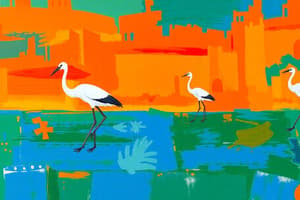Podcast
Questions and Answers
What is one of the primary factors that increases reproductive potential?
What is one of the primary factors that increases reproductive potential?
- Reproducing more often (correct)
- Reproducing fewer offspring at a time
- Reproducing in more confined spaces
- Reproducing later in life
How does reproducing early in life impact population dynamics?
How does reproducing early in life impact population dynamics?
- It shortens the generation time (correct)
- It lengthens the generation time
- It decreases the number of offspring
- It reduces the birth rate
What is an example of exponential growth?
What is an example of exponential growth?
- Decrease in predator populations over time
- Growth of a large mammal population over years
- Bacteria growing on a new food source (correct)
- Human population growth in urban areas
What limits the carrying capacity of a population?
What limits the carrying capacity of a population?
Which type of organisms generally have higher reproductive potential?
Which type of organisms generally have higher reproductive potential?
What concept describes the largest population that an environment can sustain?
What concept describes the largest population that an environment can sustain?
What is the significance of resource limits in population dynamics?
What is the significance of resource limits in population dynamics?
What typically occurs when a population exceeds its carrying capacity?
What typically occurs when a population exceeds its carrying capacity?
What is the definition of a population?
What is the definition of a population?
What does the term 'density' refer to in population studies?
What does the term 'density' refer to in population studies?
Which of the following describes the conditions for a population to maintain a stable size?
Which of the following describes the conditions for a population to maintain a stable size?
What does the growth rate equation account for in population changes?
What does the growth rate equation account for in population changes?
What happens if the reproductive potential of a population significantly decreases?
What happens if the reproductive potential of a population significantly decreases?
How might 'reproductive potential' vary among different species?
How might 'reproductive potential' vary among different species?
What do the patterns of dispersion in a population indicate?
What do the patterns of dispersion in a population indicate?
What is a factor that can control the size of a population in the long run?
What is a factor that can control the size of a population in the long run?
What is the primary characteristic of symbiosis?
What is the primary characteristic of symbiosis?
Which of the following interactions represents a situation where both species are negatively affected?
Which of the following interactions represents a situation where both species are negatively affected?
What occurs when the niches of two different species overlap?
What occurs when the niches of two different species overlap?
Which type of species interaction can still occur without direct contact?
Which type of species interaction can still occur without direct contact?
What is a likely evolutionary benefit for species with overlapping niches?
What is a likely evolutionary benefit for species with overlapping niches?
Which of the following interactions is least likely to be studied or categorized clearly?
Which of the following interactions is least likely to be studied or categorized clearly?
What does coevolution refer to in the context of symbiotic relationships?
What does coevolution refer to in the context of symbiotic relationships?
What happens to members of the same species in a competitive relationship?
What happens to members of the same species in a competitive relationship?
What primarily determines the carrying capacity of an environment for a species?
What primarily determines the carrying capacity of an environment for a species?
What is a primary consequence of members of a population competing for the same resources?
What is a primary consequence of members of a population competing for the same resources?
What defines a territory in ecological terms?
What defines a territory in ecological terms?
What distinguishes density dependent causes of death from density independent causes?
What distinguishes density dependent causes of death from density independent causes?
Which of the following is an example of a density independent cause of death in a population?
Which of the following is an example of a density independent cause of death in a population?
How is a niche different from a habitat?
How is a niche different from a habitat?
What is one of the pressures of natural selection within a population?
What is one of the pressures of natural selection within a population?
Which of the following scenarios illustrates indirect competition among species members?
Which of the following scenarios illustrates indirect competition among species members?
What is niche restriction?
What is niche restriction?
How can competition between species be reduced?
How can competition between species be reduced?
What distinguishes a parasite from a predator?
What distinguishes a parasite from a predator?
What is mutualism?
What is mutualism?
In a predator-prey relationship, what typically happens to the population sizes?
In a predator-prey relationship, what typically happens to the population sizes?
What is the primary benefit for parasites in their relationship with hosts?
What is the primary benefit for parasites in their relationship with hosts?
Which of the following best describes commensalism?
Which of the following best describes commensalism?
What happens to Chthamalus_stellatus when another barnacle species is removed?
What happens to Chthamalus_stellatus when another barnacle species is removed?
Study Notes
What is a Population?
- Group of organisms of the same species living in a specific area and breeding together
- Considered a reproductive group as organisms usually breed within their own population
- Refers to both the group and the number of individuals in it
Properties of Populations
- Density: Number of individuals of the same species per unit area
- Dispersion: Pattern of distribution of organisms within a population
- Even, clumped, or random
How Does a Population Grow?
- Growth rate determined by:
- Births
- Deaths
- Growth rate can be positive, negative, or zero
- For zero growth, births must equal deaths
- Negative growth indicates more deaths than births
How Fast Can a Population Grow?
- Populations usually stay relatively stable due to factors that limit growth
- These factors determine long-term population evolution
Reproductive Potential
- Biotic potential: Maximum rate of population growth for a species
- Reproductive potential: Maximum number of offspring a given organism can produce
- Factors influencing reproductive potential:
- Number of offspring per reproduction
- Frequency of reproduction
- Age of first reproduction
Biotic Potential
- Shortening generation time (time to reach reproductive age) increases reproductive potential
- Small organisms (bacteria, insects) have short generation times and high reproductive potential
- Large organisms (elephants, humans) have long generation times and lower reproductive potential
Exponential Growth
- Logarithmic growth where numbers increase by a factor in each time period
- Occurs in nature when resources are plentiful and there's no competition or predation
- Example: Bacterial or mold growth on a new food source
What Limits Population Growth?
- Natural conditions are not ideal or constant
- Resource depletion and environmental changes lead to increased deaths or decreased births
- Natural selection dictates which individuals survive and reproduce
Carrying Capacity
- Maximum population size an environment can sustainably support
- Populations can exceed carrying capacity temporarily but cannot remain at that higher size
- Difficult to predict or calculate precisely due to ecosystem fluctuations
Carrying Capacity - Resource Limits
- Carrying capacity reached when resource consumption equals production rate
- Limiting resource: The most severely limited resource, determining carrying capacity
- Supply of the limiting resource dictates carrying capacity
Competition Within a Population
- Members of the same species compete for resources
- Competition can be direct (for resources) or indirect (for social dominance or territory)
- Competition is a driving force of natural selection
Competition Within a Population
- Territory: An area defended by an individual or group against others
- Value of territory lies in space, shelter, food, or breeding sites
- Organisms invest time and energy in competing for mates, food, or home
Two Types of Population Regulation
- Density-dependent regulation: Death rates higher in a crowded population
- Density-independent regulation: Proportion of the population dies regardless of density
Population Regulation
- Density-dependent factors:
- Limited resources
- Predation
- Disease
- Density-independent factors:
- Severe weather
- Natural disasters
An Organism's Niche
- Niche: Unique position of a species in its habitat, considering resource use and ecological role
- Distinct from habitat: Habitat is a location, niche is a pattern of resource use
- Niche can be viewed as the species' "functional role" in an ecosystem
Symbiosis and Coevolution
- Symbiosis: Close association between two different species
- Often involves benefit to at least one species
- Coevolution: Species in close relationships evolve adaptations to improve the relationship or reduce harm
ways in Which Species Interact
- Competition
- Predation
- Parasitism
- Mutualism
- Commensalism
Species Interactions
- Categorized based on benefit or harm to each species
- Interactions can be indirect, unclear, or rarely observed
Competition
- Two species (or individuals) using the same limited resource, resulting in negative effects for both
- Intraspecific competition: Competition within the same species
- Interspecific competition: Competition between different species with overlapping niches
Indirect Competition
- Competition even without direct contact
- Example: Insects feeding on the same plant at different times
Adaptations to Competition
- One species may outcompete another
- Evolution favors adaptations that reduce competition
- Niche restriction: Species using less of their potential niche to reduce overlap
Predation
- One species (predator) feeds on another (prey)
- Predators can also be prey
- Prey organisms evolve mechanisms for predator avoidance or defense
Predators
- Some predators have specialized diets
- Population sizes of predator and prey can fluctuate in linked patterns
Parasitism
- Parasite: Organism living in or on another (host) and feeding on it
- Examples: Ticks, fleas, tapeworms
- Parasite benefits, host is usually harmed but not killed
- Parasites may have an evolutionary advantage in keeping the host alive longer
Mutualism
- Both species benefit from the relationship
- Example: Bacteria in your intestines breaking down food for you, while you provide their habitat
Commensalism
- One species benefits, the other is unaffected
Studying That Suits You
Use AI to generate personalized quizzes and flashcards to suit your learning preferences.
Related Documents
Description
This quiz explores the concept of populations in ecology, covering definitions, properties, growth rates, and reproductive potential. Test your knowledge on how organisms interact within their populations and the factors affecting their growth. Perfect for biology students looking to deepen their understanding of population dynamics.




